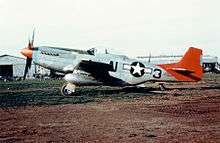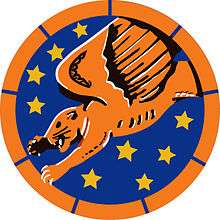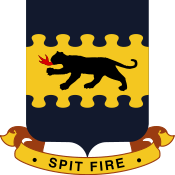George Hardy (Tuskegee Airman)
LT COL George Hardy (born June 8, 1925) is a highly decorated member of the famed group of World War II-era African-American pilots known as the Tuskegee Airmen. Hardy had a 30 year military career and he flew combat missions in three wars. In World War II Hardy flew 21 combat missions. In the Korean War he flew 45 combat mission as the pilot of a bomber. In the Vietnam War Hardy flew flew 70 combat missions piloting an AC-119K gunship.[3]
Lieutenant Colonel George Hardy | |
|---|---|
 | |
| Birth name | George Edward Hardy[1] |
| Born | June 8, 1925[2] Philadelphia, PA |
| Allegiance | |
| Service/ | United States Army Air Force |
| Years of service | 1943-1971 |
| Rank | Lieutenant Colonel |
| Unit | 332nd Fighter Group |
| Awards |
|
| Spouse(s) | 2nd wife Bonnie |
Military service
World War II

In 1943 when Hardy was 17, he joined the Army Air Corps that same year he began training to fly at the Tuskegee Air Field late.[5][6] He was deployed to Keesler Army Air Field in Biloxi, Mississippi for basic training.[3] He graduated in 1944 as a second Lieutenant in the United States Army. He was qualified to fly single engine planes and sent to Walterboro Army Air Field in South Caroline to train for combat. He completed his combat training in 1945 and was then sent to Italy.[7] Hardy became one of only 350 Tuskegee Airmen who were deployed overseas. He flew 21 combat missions over Germany in 1945.[3] The majority of his missions he escorted bombers to their targets. After the war, Hardy went back to Tuskegee to train pilots.[8]
Korean War
Hardy was recalled in 1948 and sent to Keesler Air Force Base in Mississippi. He was sent to Guam with the 19th Bomb Group. He then was sent to Kadena Air Base, Okinawa: he flew a B-29 and piloted 45 combat missions over Korea.[7] One senior officer disliked Hardy because of his race and he removed him from a B-29 mission. That B-29 was shot down in North Korean airspace.[9]
Vietnam War
Hardy flew 70 missions piloting a C-119 gunship in the Vietnam War.[8] He flew missions at night using infrared to destroy North Vietnamese supply routes and convoys in Laos and Cambodia.[3]
Awards





- Congressional Gold Medal (2007)[11]
Hardy remembers the exact words that George Bush said the to Tuskegee Airmen as he awarded the Congressional Medal: “For most of the salutes you didn’t get, I salute you.”[11]
Education
- Walter George Smith School[1]
- South Philadelphia High School[1]
- Bachelor of Science Degree - Electrical Engineering
- Master of Science Degree - Systems Engineering-Reliability - U.S. Air Force Institute of Technology
- Honorary Doctorate of Public Service from Tuskegee University.[5]
Personal life
Hardy's parents names were Edward Hardy and Alma Vargas.[1] He was exposed to racism and segregation growing up in Philadelphia, Pennsylvania.[5] He graduated high school in 1942 and wanted to join the military because his older brother had joined the U.S. Navy in 1941.[12] When he joined the Army Air Corps in 1943 the U.S. military was segregated.[5] Hardy faced descrimination from commanders in the Army.[6] After WWII (1947) Hardy went to school at New York University School of Engineering and Science until 1948.[7] Hardy wanted to be an Engineer, he did not plan to make a career in the Air Force.[10]
Hardy was one of 188 Tuskegee airmen at President Barack Obama’s first inauguration.[8]
He now travels the country telling the story of the Tuskegee Airmen and speaking about segregation[13] He lives in Sarasota, Florida.
References
- "George Edward Hardy". Cincinnatilibrary. The Public Library of Cincinnati and Hamilton County. Retrieved July 25, 2019.
- Miller, S. "A Birthday to Remember: Tuskegee Airman Celebrates Birthday Onboard". southwestaircommunity. Southwest Airlines Co. Retrieved July 23, 2019.
- Cox, Billy (April 20, 2016). "George Hardy, 90, flew 21 combat missions in the spring of 1945". Gatehouse Media LLC. Retrieved July 23, 2019.
- Rice, Markus. "The Men and Their Airplanes: The Fighters." Tuskegee Airmen, 1 March 2000.
- Fowler Jr., Vernon L. "MacDill hosts a Tuskegee Airman". amc. Official United States Air Force Website. Retrieved July 23, 2019.
- Shastri, Devi (July 28, 2018). "The Tuskegee Airmen fought a world war and racism. Now, they're telling kids their story". Oshkosh Northwestern. Retrieved July 23, 2019.
- "George E. Hardy". redtail. CAF Red Tail Squadron. Retrieved July 23, 2019.
- Dean, Vicki (October 18, 2018). "Sarasota resident George Hardy reflects on his service as Tuskegee Airman". Gatehouse Media LLC. Retrieved July 23, 2019.
- Avery, Brad (October 27, 2015). "Tuskegee Airmen give speech on race, history at Framingham State". Gatehouse Media LLC. Retrieved July 23, 2019.
- Erickson, Jim. "Honoring Heroes". newsmagazinenetwork. West Media Inc. Retrieved July 23, 2019.
- Rojas, Josh. "Tuskegee Airman George Hardy, 87, Broke Down Racial Barriers". postnewsgroup. Post News Group. Retrieved July 25, 2019.
- DuBois, Maya. "A living legend visits FAMU". thefamuanonline. College Media Network. Retrieved July 23, 2019.
- Dunlap, Tiare. "Veterans from World War II's All-Black Aviation Unit on How They Shattered Racial Stereotypes: 'We Proved That Thinking Wrong'". people. Meredith Corporation. Retrieved July 23, 2019.
Notes
- The red markings that distinguished the Tuskegee Airmen included red bands on the noses of P-51s as well as a red rudder; their P-51B and D Mustangs flew with similar color schemes, with red propeller spinners, yellow wing bands and all-red tail surfaces.[4]
External links
- Tuskegee Airmen at Tuskegee University
- Tuskegee Airmen Archives at the University of California, Riverside Libraries.
- Tuskegee Airmen, Inc.
- Tuskegee Airmen National Historic Site (U.S. National Park Service)
- Tuskegee Airmen National Museum
- Fly (2009 play about the 332d Fighter Group)
- Executive Order 9981
- List of African American Medal of Honor recipients
- Military history of African Americans
